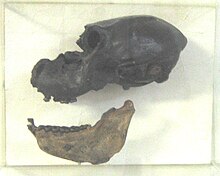Cuban monkey
|
Paralouatta Temporal range: Miocene– |
|
|---|---|
 |
|
| Paralouatta marianae skull | |
| Scientific classification | |
| Kingdom: | Animalia |
| Phylum: | Chordata |
| Class: | Mammalia |
| Order: | Primates |
| Family: | Pitheciidae |
| Subfamily: | Callicebinae |
| Tribe: | †Xenotrichini |
| Genus: |
†Paralouatta Rivero & Arredondo, 1991 |
| Species | |
|
|
Paralouatta is a platyrrhine genus that currently contains two extinct species of small primates that lived on the island of Cuba.
The Cuban fossil primate, Paralouatta varonai was described from a nearly complete cranium from the late Quaternary in 1991. This cranium and a number of isolated teeth and postcranial bones were found in a cave site in Pinar del Río Province. The initial description of the cranium included a proposal that Paralouatta varonai was a close Caribbean relative of the extant Alouatta (howler monkeys) of Central and South America, but this taxonomic placement has been called into question with the analysis of the dental remains. Based on shared similarities with the two other Caribbean primates Xenothrix mcgregori and Antillothrix bernensis, MacPhee and Horovitz have proposed that the Caribbean primates are part of a monophyletic radiation which entered the Caribbean at the Oligocene–Miocene boundary. More recent research confirms this assessment and places these three species in the tribe Xenotrichini. Limb modifications and its large size suggest it was partly terrestrial, and a likely example of island gigantism.
A second species of Paralouatta (P. marianae) has also been described from early Miocene deposits (~18 million years old), and is the largest Neotropic primate known of that epoch.
...
Wikipedia
